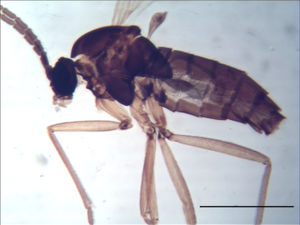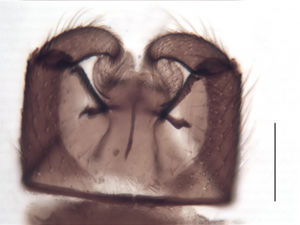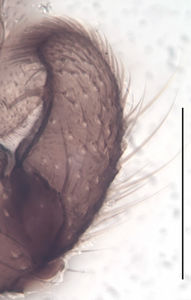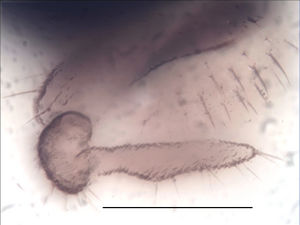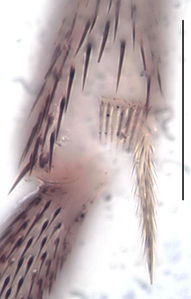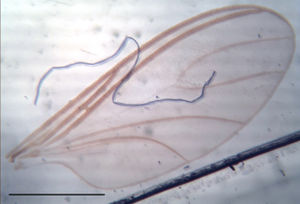Bradysia pectinata
Ordo: Diptera
Familia: Sciaridae
Genus: Bradysia
Name
Bradysia pectinata Winnertz, 1867 – ZooBank link
Type material
Lectotype ♂, no. 660 in SFNF, leg. C. von Heyden
Type locality
Germany, Frankfurt
Material studied
Germany: 2 ♂, Bavaria, Oberstdorf, Breitachklamm, shore vegetation, sweep netting, Heller, 23.05.2004, PKHH 4173, 4174 [in SDEI]
Description (male)
Head. Eye bridge 3–4 rows of facets. Antenna unicolour. LW-index of 4th flagellomere 2.4–2.7; neck 0.23–0.27 × segment width; transition of basal part to neck pronounced. Colour of neck unicolour. Antennal setae shorter than segment width, or as long as segment width; of normal strength; dense. Sensillae absent. Antennal setae adjacent. Palpus darkened; long; palpomeres 3. First palpomere elongate; with 5–7 setae; with only sparse sensilla. Second palpomere short and oval. Third palpomere as long as first. Thorax. Colour brown. Notum unicolour. Thoracic setae weak; white. Posterior pronotum bare. Mesothoracic sclerites bare. Legs. Colour yellow-brown. Hind coxa of same colour as femora. Setae on front coxa pale. Front tibial organ as distinct, delimited comb; pale; front tibial organ not bordered. Tibial comb undivided. Tibial comb with 7 bristles. Tibial setae on hind legs weak and inconspicuous. Tibial spurs of equal length. Claws untoothed. Wing. Wing slightly darkened; of normal shape. Wing membrane without macrotrichia. Wing venation weak, with faint stM. M-fork of normal shape. R1 ending clearly before base of m-fork; posterior veins bare; bM bare; r-m bare; bM:r-M 0.75–0.9; st-Cu:bM 0.6–0.75; R1:R 0.8–1; c:w 0.66–0.76. Halter darkened; of normal length. Abdomen. Abdominal setae weak; sparse; on tergites white; on sternites white. Hypopygium concolour with abdomen; LW-index 0.61–0.72. Base of gonocoxites bare; gonocoxites broadly separated; inner margin of gonocoxites broadly extended; inner membrane of hypopygium scarcely setose; ventral margin of gonocoxite with elongate setae. Gonostylus elongate; LW-index 2.4–2.8; Inner margin concave; apex equally rounded. Apical tooth absent. Awl-like setae absent. Megasetae present; number of megasetae 1; thick; curved; in one group. Position of basalmost megaseta 26–32 % from top. Whiplash-hair absent. Tegmen 0.48–0.55 × longer than broad; equally rounded; without special features; central process absent. Length of ejaculatory apodeme/hypopygium 34–45 %; base of ejaculatory apodeme absent. Field with aedeagal teeth clearly visible. Measurements. Body size 2.5–3.4 mm. Hind tibia 1.32–1.5 mm. Wing length 3–3.8 mm.
Diagnosis
Bradyisa pectinata was placed in the Bradysia hilaris group[2] and can be readily identified by the isolated, strong mesial megaseta at the gonostylus, which is unique for Central European Bradysia species. A similar arrangement can be found in Bradysia noduspina Yang, Zhang & Zhang, 1993[3] from China.
Discussion
Lengersdorf (1930: 41)[4] considered Bradysia pectinata as identical to Bradysia pauperata, which was correcly discardad by Menzel & Mohrig[2] based on the differences in the gonostylus and the apically setose r-m vein. The newly recorded specimens from Bavaria, however, do not have setae on r-m, but otherwise agrees well with the lectotype. Also, the habitat shore of a gorge valley differs notably from the type, which was collected in a hollow beech tree. The presence of a very similar species from China indicates, that there probably exists a complex of closely related species. But as long as no more specimens from Europe are known, the new material is tentatively identified as conspecific with B. pectinata.
Etymology
lat. pectinatus = combed.
Distribution
Germany[1].
Images
|
References
- ↑ 1.0 1.1 Winnertz, J. 1867: Beitrag zu einer Monographie der Sciarinen. W. Braunmüller, Wien. BHL
- ↑ 2.0 2.1 2.2 Menzel, F.; Mohrig, W. 2000: Revision der paläarktischen Trauermücken (Diptera: Sciaridae). Studia dipterologica Supplement 6, 1-761. AMPYX-Verlag, Halle.
- ↑ Yang, C.K.; Zhang, X.M.; Yang, C.Q. 1993: Taxonomic studies on the Sciaridae (Diptera: Nematocera) of Guizhou. Entomotaxonomia, 15(4), 283–318.
- ↑ Lengersdorf, F. 1930: 7. Lycoriidae (Sciaridae). In: E. Lindner (Ed.), Die Fliegen der palaearktischen Region (2(1)). E. Schweizerbart’sche Verlagsbuchhandlung, Stuttgart, 1–71.
